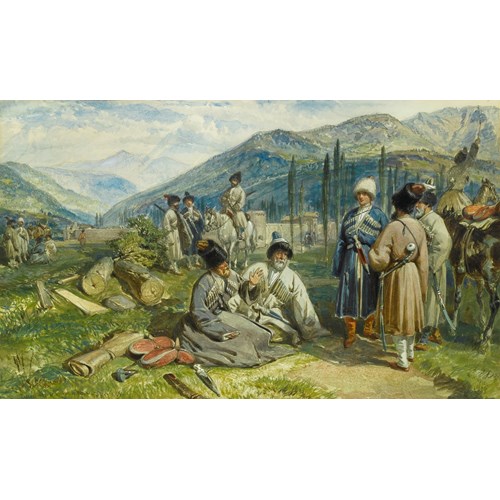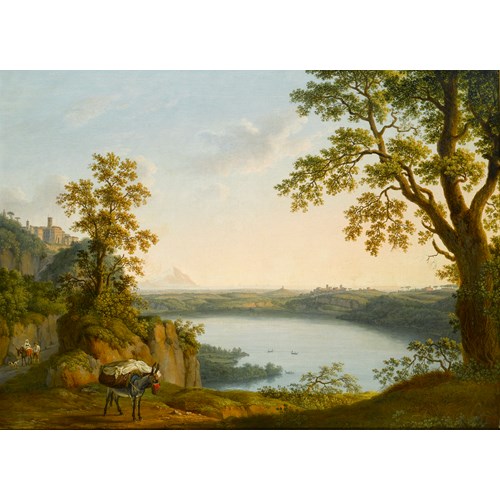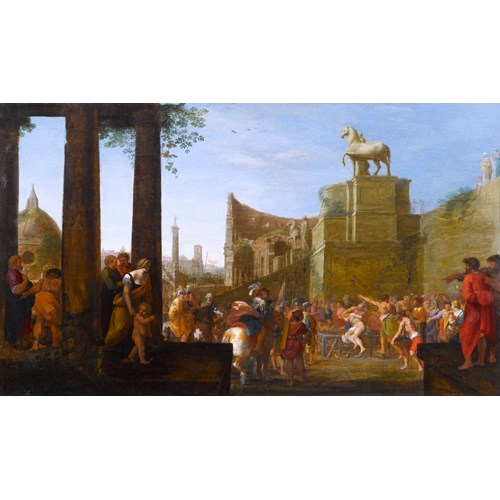Marketplace
A View of St. Peter's Basilica, Rome
Gaspar van Wittel, called Vanvitelli
A View of St. Peter's Basilica, Rome
Period 1600-1750, 17th century, 18th century
Origin Italy, The Netherlands
Medium Oil on canvas
Dimension 27 x 65 cm (10⁵/₈ x 25⁵/₈ inches)
A View of St. Peter’s Basilica, Rome, attributed to the circle of Gaspar van Wittel, called Vanvitelli, offers a stunning panorama of the distinctive piazza, as well as an excellent record of the dress and activities of early eighteenth-century visitors to the site. The attention to detail is extraordinary, revealing intricacies in the decoration of the church’s façade and the gestures and movements of the men, women and children strolling through the grounds. A cross-section of Roman society is represented, from aristocrats to beggars, monks to street vendors, and in examining the painting, the viewer feels genuinely transported back in time.
Vanvitelli painted at least fourteen variations of this view of the Piazza San Pietro, which date from 1684 to 1721.¹ It was one of his most popular compositions, and they all derive from a preparatory drawing in Bibliotheca Nazionale in Rome.² However, despite the setting remaining the same throughout these works, the activity taking place in the piazza varies greatly. The arrangement of figures in our painting is very close to those in a larger canvas by a close follower of Vanvitelli.³
Prior to Vanvitelli, artists such Viviano Codazzi (c.1604-1670) and the German Johann Wilhelm Baur (1607-1642) were producing stylistically similar vistas of Rome. Codazzi, who was mainly active in Rome, was the foremost architectural painter of his generation. He depicted St. Peter’s c.1630, which shows the site before Gianlorenzo Bernini’s (1598-1680) colonnade was built, and offers an interesting comparative view to the present work. Baur instead specialised in miniature views of the city and developed the veduta ideate, which combined observed details with the artist’s imagination. The present work, however, appears to display a highly realistic view, precisely recording architectural features and the Roman populace.
Vanvitelli was a Dutch painter and draughtsman who trained in the workshop of Matthias Withoos (1627-1703) in Amersfoort before venturing to Rome, where his presence was first recorded in 1675. Apart from visits to Lombardy and Naples, he spent the remainder of his life in Rome, devoting himself to topographical views of the city, showing it not only as the site of ancient ruins but also of modern creations such as St. Peter’s Basilica. In the rare instances that he painted more conventional images of Roman ruins, he did so from different and novel viewpoints. His style was well-established by the 1690s, and his principles in composition and perspective remained constant throughout the rest of his career, with only the subject matter changing. He was careful to represent his architectural subjects accurately, from a point of view that corresponded with that of the spectator. In his studio, Vanvitelli often produced multiple versions of a single view based on drawings that he had executed on site.
¹ Briganti, G., Gaspar van Wittel (Milan, 1996), pp. 168-172.
² Ibid, cat. no. 314.
³ Ibid, p. 172, cat. no. [r].
Vanvitelli painted at least fourteen variations of this view of the Piazza San Pietro, which date from 1684 to 1721.¹ It was one of his most popular compositions, and they all derive from a preparatory drawing in Bibliotheca Nazionale in Rome.² However, despite the setting remaining the same throughout these works, the activity taking place in the piazza varies greatly. The arrangement of figures in our painting is very close to those in a larger canvas by a close follower of Vanvitelli.³
Prior to Vanvitelli, artists such Viviano Codazzi (c.1604-1670) and the German Johann Wilhelm Baur (1607-1642) were producing stylistically similar vistas of Rome. Codazzi, who was mainly active in Rome, was the foremost architectural painter of his generation. He depicted St. Peter’s c.1630, which shows the site before Gianlorenzo Bernini’s (1598-1680) colonnade was built, and offers an interesting comparative view to the present work. Baur instead specialised in miniature views of the city and developed the veduta ideate, which combined observed details with the artist’s imagination. The present work, however, appears to display a highly realistic view, precisely recording architectural features and the Roman populace.
Vanvitelli was a Dutch painter and draughtsman who trained in the workshop of Matthias Withoos (1627-1703) in Amersfoort before venturing to Rome, where his presence was first recorded in 1675. Apart from visits to Lombardy and Naples, he spent the remainder of his life in Rome, devoting himself to topographical views of the city, showing it not only as the site of ancient ruins but also of modern creations such as St. Peter’s Basilica. In the rare instances that he painted more conventional images of Roman ruins, he did so from different and novel viewpoints. His style was well-established by the 1690s, and his principles in composition and perspective remained constant throughout the rest of his career, with only the subject matter changing. He was careful to represent his architectural subjects accurately, from a point of view that corresponded with that of the spectator. In his studio, Vanvitelli often produced multiple versions of a single view based on drawings that he had executed on site.
¹ Briganti, G., Gaspar van Wittel (Milan, 1996), pp. 168-172.
² Ibid, cat. no. 314.
³ Ibid, p. 172, cat. no. [r].
Period: 1600-1750, 17th century, 18th century
Origin: Italy, The Netherlands
Medium: Oil on canvas
Dimension: 27 x 65 cm (10⁵/₈ x 25⁵/₈ inches)
Provenance: Dorotheum, Vienna, 14 March 1978, lot 142;
Christie’s, London, 4 July 1986, lot, 62;
Lempertz, Cologne, 22 May 2004, lot 1169.
Literature: Giuliano Briganti, Gaspar van Wittel (Milan, 1996), p. 172.
More artworks from the Gallery









